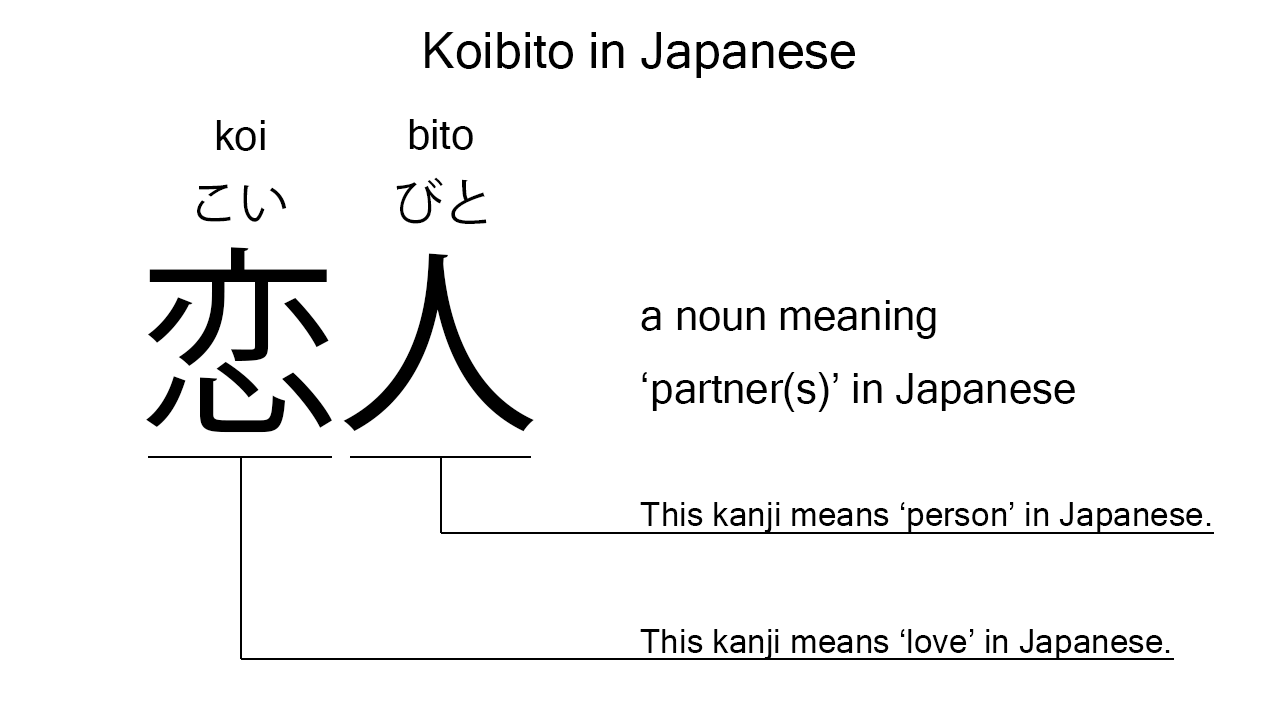What does “koibito” mean in Japanese?
Native speakers say “koibito” often to mean ‘partner’ in Japanese. Perhaps, some Japanese learners know this word as it is sometimes used in Japanese movies, songs, novels, manga, anime, and the like. In this blog post, however, I will explain this word in detail based on its kanji expression. And also, I will explain how to use it through example sentences. My explanations would help Japanese learners understand “koibito” more clearly. Then, let’s get started!
Contents
Definition and meanings of “koibito”
Let me start with the definition and meanings of “koibito”.
- koibito – 恋人 (こいびと) : a noun meaning ‘partner’ or occasionally ‘lover’ in Japanese. This can also work as plural. Learn more about Japanese plural. Depending on the context and situation, this can also mean ‘boyfriend’ or ‘girlfriend’.
Native speakers use this noun to refer to a person with whom they have a romantic relationship.
The definition and meanings are simple and clear, I think. To understand this noun more clearly, however, let me explain its kanji characters in detail, one by one.
What does “koibito” literally mean in Japanese?
The kanji expression of “koibito” consists of the following two kanji characters:
- 恋 : a kanji character used to mean ‘love’ in Japanese. This can also be found in other words like “hatsukoi“.
- 人 : a kanji character used to mean ‘person’ in Japanese.
These two kanji characters tell us that “koibito” literally means a ‘person to love’ in Japanese. So, what the kanji characters express is completely in line with the actual meanings. In addition, it does not contain any word determining the gender of a partner. It can, therefore, refer to a partner regardless of their gender.

When we meet new kanji expressions, we should check their kanji characters in detail to understand their meanings clearly and deeply. In many cases, kanji characters tell us a lot about the meanings of the expressions they form. Actually, here, we could get the better understanding of “koibito” through the detailed kanji check above.
So far, I’ve explained the definition and meanings of “koibito” together with its kanji characters. Then, let me explain how to use it through the example sentences below.
Example #1: how to say “partner” in Japanese
kanojo wa boku no koibito desu – 彼女は僕の恋人です (かのじょはぼくのこいびとです)
She is my partner.
Below are the new words used in the example sentence.
- kanojo – 彼女 (かのじょ) : a pronoun meaning ‘she’ in Japanese.
- wa – は : a binding particle working as a case marker or topic marker. In the example, this works after “kanojo” to make the subject in the sentence.
- boku – 僕 (ぼく) : a pronoun meaning ‘I’ in Japanese. This is used mainly by boys and young males.
- no – の : a case particle used after a noun or pronoun to make its possessive case. In the example, this is used after “boku” to make its possessive case, “boku no”, which means ‘my’ in Japanese.
- desu – です : an auxiliary verb used after a noun or adjective to make it polite. Probably, this is well known as a part of Japanese desu form. In the example, this is used after “boku no koibito” to make it sound polite.
This is a typical usage of “koibito”. In this example, it works together with the possessive case, “boku no”, to mean ‘my partner’ in Japanese. When we want to mean a ‘partner’ in Japanese, anyway, this noun is a very good option.
Example #2: another usage of “koibito”
watashi no koibito wa totemo kakkoii desu – 私の恋人はとてもかっこいいです (わたしのこいびとはとてもかっこいいです)
My boyfriend is very handsome.
Below are the new words used in the example sentence.
- watashi – 私 (わたし) : a pronoun meaning ‘I’ in Japanese. In the example, this works together with the case particle, “no”, to say “my” in Japanese.
- totemo – とても : an adverb of degree meaning ‘very’, ‘much’, ‘so’, or such in Japanese. In the example, this works in front of “kakkoii” to emphasize its meaning.
- kakkoii – かっこいい : an i-adjective meaning ‘handsome’ or such in Japanese.
This is another typical usage of “koibito”. In this example, it works as a part of the noun phrase, “watashi no koibito”, which means ‘my boyfriend’ in Japanese. Again, but it can also mean ‘boyfriend’ depending on the context and situation.
Summary
In this blog post, I’ve explained the definition and meanings of “koibito” in detail based on its kanji expression. And also, I’ve explained how to use it through the example sentences. Let me summarize them as follows.
- koibito – 恋人 (こいびと) : a noun meaning ‘partner’ or occasionally ‘lover’ in Japanese. This can also work as plural. Depending on the context and situation, this can also mean ‘boyfriend’ or ‘girlfriend’. These two kanji characters literally mean a ‘person to love’ in Japanese. So, what the kanji characters express is completely in line with the actual meanings. In addition, this does not contain any word determining the gender of a partner. This noun can, therefore, refer to a partner regardless of their gender.
Hope my explanations are understandable and helpful for Japanese learners.